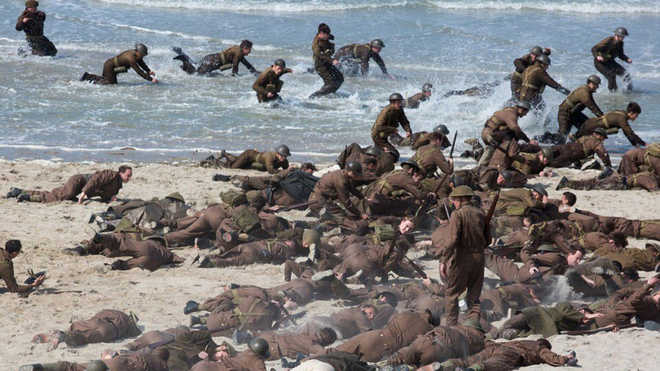Navnee Likhi
“We shall go on to the end, we shall fight on the seas and oceans, we shall fight with growing confidence and strength in the air, we shall not surrender.”
— Winston Churchill
British-American film director Christopher Nolan’s war drama Dunkirk centres around true events that took place in 1940, after Germany had invaded France. Thousands of British expeditionary forces retreated, along with the French and their allies to the sea-side town of Dunkirk. As the allied perimeters shrank, German forces closed on. The soldiers awaited their evacuation in this grim situation. Operation Dynamo was started by providing air and ground cover for the British and French forces. Troops were slowly and methodically lifted from the beach using flotilla of nearly 700 civilian boats. Boats were used as the water was too shallow for bigger ships to shore up. The mission ended with nearly 3,58,000 soldiers safely rescued, though some died and some were captured by the Germans.
The story is intense and nerve-wrenching. The director revisits a harrowing account of survival and resistance set during the Second World War. Using his skill, he crafted three separate narratives over three time frames: land, sea and air. Soldiers trapped on the beach to be retrieved over a course of one week. The sea operation to be completed in 24 hours followed by the Royal Air Force pilot sorties over an hour. The film is not a traditional war film as there aren’t any ground battle scenes. The action sequences that take place are tightly packed. Cinematographer Hoyte Van Hoy Lima has created, edge-of-the-seat scenes.
In the opening scene of the movie, a group of British soldiers are shown wandering in the deserted French seaside town of Dunkirk. It is May 1940, nine months after the war started. The soldiers walk down the much too quiet streets. The Germans are dropping propaganda leaflets as ominous warnings to the British troops reminding them of the hopeless situation they are caught in. “We surround You” is written as the text of the leaflets asking them to surrender and survive. Before they have the chance to run for cover, German soldiers fire at them. Only one British soldier Tommy escapes the gunfire and makes it to the beach where he finds thousands of soldiers of British and allied groups waiting to be evacuated.
Here he befriends Gibson, a French soldier. Both board a ship which is attacked as it departs. In this chaos, they save another soldier Alex. The three embark on another ship which is torpedoed. In one of the attempts to save their lives when trying to escape on a sinking boat, Gibson gets entangled in chains and drowns. Tommy and Alex swim to a nearby minesweeper, which is sunk by a bomber. They are narrowly rescued.
On the land are present Commander Bolton and Colonel Winant representing the navy and army, respectively. The Royal Navy commissions private boats in an effort to rescue soldiers. The British deploy an armada of privately owned, smaller vessels to assist in rescue operations. A mariner, Mr Dawson volunteers to sail towards Dunkirk in his boat — Moonstone — in the face of death. He is accompanied by his son Peter and a family friend George. As they sail, they sight a sinking ship — with a soldier perched upon its upturned hull. Dawson rescues him, pulling him aboard on the boat. The soldier is shell shocked. He is reluctant to go down below the deck of the boat, fearing he might drown. He is at odds with Mr Dawson and his men. He tries to take over the boat and enters into a scuffle with George, hits him on the head, resulting in his death. They encounter a minesweeper-turned transport, which is attacked by German Heinkel bomber plane. Mr Dawson manoeuvers to take on troops from the sinking ship. He, along with his crew, rescue as many surviving soldiers as he could. Mr Dawson exudes unimaginable stoic goodness in sea operations. He says, “My story is an example of civilian bravery in a violent situation. I hope they take encouragement in that, no matter how powerless they feel.”
The air operations are the most literal representation of the clock-ticking narrative, as these take place in the course of an hour. Three spitfires piloted by Farrier, Collins and their Squadron leader Fortis head cross the English Channel to provide support to rescue operations at Dunkirk. They encounter German Luftwaffe fighter planes and enter into dogfight with them, during which Fortis plane is shot down and Farrier assumes command. During several aerial strikes, Farrier’s and Collins’planes are damaged. Collins has to make an emergency landing on the sea. This leads to terrifying, near downing scene as he gets trapped in his cockpit and water floods in. He is rescued at the last minute by the crew of Moonstone, which happens to be nearby, when the plane hit the sea. Farrier, meanwhile, remains airborne fighting off the German planes. His plane fuel gauge gets damaged. He continues to fly through the air giving cover to British ships and troops squeezed on to the docks. This lends eerie silence to these moments, mixed with serenity and anxiety. More private boats show up on the waters to rescue soldiers. Farrier shoots down the German bomber plane. He lands his plane slowly by the shore and on landing, he sets it on fire. Later, he is captured by the Germans.
Mr Dawson and his crew return home in Weymouth after the rescue operations. Commander Bolton stays back to make sure allied soldiers are evacuated.
The story of Dunkirk conveys that against insurmountable odds and spectre of annihilation, human spirit will triumph inspiring all to hold on and never to surrender.
Unlock Exclusive Insights with The Tribune Premium
Take your experience further with Premium access.
Thought-provoking Opinions, Expert Analysis, In-depth Insights and other Member Only Benefits
Already a Member? Sign In Now










